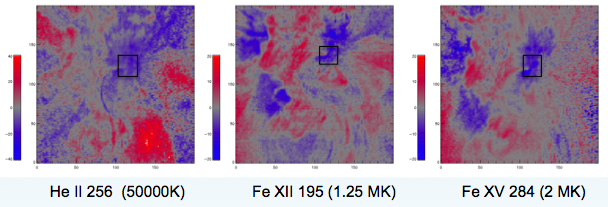So what is a sunspot light-bridge?
Light-bridges are lanes of bright material that divide the umbra in a sunspot. They are often observed during the break-up of sunspots and therefore can represent the re-establishment of convection which is normally inhibited by the sunspot's strong magnetic field. Their increased brightness suggests a higher plasma temperature than in the surrounding umbra, and they have been shown to display significantly enhanced chromospheric brightness and activity, including
jets and surges (e.g.
Roy (1973); Asai et al. (2001); Berger & Berdyugina (2003); Shimizu et al. (2009); Louis et al. (2009) ). They are one of the key surface phenomena that relates directly to sunspot sub-surface structure as measurements of their convective and magnetic characteristics are useful for differentiating between monolithic and cluster models of sunspots. This makes light-bridges interesting on many levels.
Coronal activity above light-bridges
As mentioned above, light-bridges often show significant enhanced activity and dynamic behaviour in the chromosphere. The question we want to ask here is whether or not that activity has any accompanying signatures higher up in the Sun's atmosphere in the transition region and the corona that might
indicate that light-bridges provide a bridge between the photosphere and the corona. Hinode provides an ideal tool for us to do this with its high resolution imaging of the photosphere and the chromosphere from SOT, coupled with plasma diagnostics of the transition region and the corona from EIS. We pick an example from April/May 2007 where Hinode tracked active region 10953 for several days that included the formation and disappearance of a light-bridge. The figure above shows the region as seen in the G-band filter of the SOT on 30 April 2007. The EUVI instrument that forms part of the SECCHI suite on STEREO also observed this region, and we use that data to supplement the EUV information available from EIS.
Our light-bridge showed plenty of enhanced chromospheric activity during its lifetime and in the figure below we show one particular episode seen in SOT's Ca II H, Halpha and EUVI's 171 A channel. Interestingly, the coronal brightening is almost precisely coincident in time with a Ca II H jet.

So we see some evidence of the light-bridge activity in coronal images, but what do we see when we look with EIS? Well, we see strong evidence of the light-bridge in He II intensity and indications of it in the coronal lines. The capability of EIS to show us velocity space has often demonstrated lots of dynamic activity in regions of low intensity in the corona. In this case we find that our light-bridge is situated in the vicinity of the now famous active region outflows, but that the velocities associated with the light-bridge are much lower; only a few km/s, as can be seen below (blue areas represent flows directed toward us, red areas represent flows away from us and back to the solar surface).

So, are light-bridges a bridge to the corona? Well, intensity enhancements above light-bridges seem to extend substantially higher into the corona than previously thought which supports the idea of some kind of connection, and variations in coronal intensity seem to show a surprisingly good correlation between Ca II and 171 Å. But, the velocities of plasma flowing out above the light-bridge are much lower than their surroundings. Watch this space!


